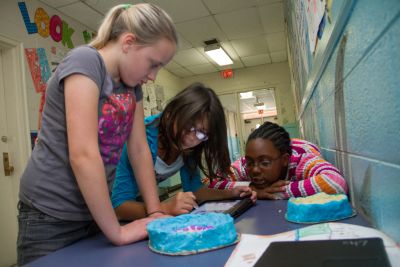The weather is warmer, and the kids are getting restless. Ask any parent or teacher, and she’ll tell you the last month of the school year is one of the hardest times to get students to focus on their studies.
In Virginia, SOL testing is finished and the end of the year is on the horizon. But, says Longwood University education professor Dr. Christopher Jones, if teachers and parents approach this last month the right way, it can be full of opportunities to learn.
Tips for teachers
Project time!
Teachers are under pressure to spend much of the school year focused squarely on prepping students for high-stakes testing at the end of the year. Now that the testing is over and everyone has breathed a sigh of relief, there’s an opportunity for fun learning.
"One of the biggest challenges for teachers is finding time to fully develop exciting projects that coincide with the instruction. Sometimes teachers feel compelled to cut out the creative components of instruction in order to stay on track with various pacing guides," said Jones. "Well, now is that time. This last month of the year is perfect for taking one or more of those project ideas down off the shelf and getting kids active and involved. For example, taking students outside to explore the school grounds can make a previous lesson about ecosystems very real and help them retain that knowledge."
Get up and move around
When the weather is this nice, student eyeballs naturally turn to the window—they’d rather be outside than cooped up indoors, after all. Jones encourages taking advantage of that restlessness.
"It’s time to rethink your lesson plans," he said. "Think of the concepts that they’ve been taught over the fall and winter, and try to relate them to activities you can do in and around the school building. Develop projects that utilize a variety of spaces you have available—moving students around gives them an extra jolt of energy. If you need to stay inside the classroom, develop shorter modules in different areas around the room. When students are finished with one, physically moving to another area of the classroom motivates them to give some extra attention."
Cut down on homework
Homework: the bane of every student’s existence. It may be tempting for teachers to assign lots of homework to get in a final push of learning over this last month, but often that tactic has the opposite effect. The key, says Jones, is giving the appropriate amount of work to take home.
"Over the winter, when test prep is in full swing, it’s probably necessary for teachers to assign homework that students can do independently," he said. "But in the spring, when the air is warmer, days longer and testing over, that same amount of homework isn’t necessary. If teachers cut way back and let students unwind a bit when they’re at home, they’ll find that students engage more when they are in school."
Tips for parents
Plenty of playtime
When children arrive home on a breezy, beautiful 85-degree day, you can bet they are itching to get outside. Let them, says Jones.
"Play has to be prioritized," he said. "The spring does something to kids—the minute they get up they are bubbling with energy and their minds are not on schoolwork. Parents have to give them what they need: lots of exercise and lots of unrestricted play. I recommend that parents schedule time for homework after a good amount of play. That way, when the same time comes around every day, transitioning back to school mode is easier for your kids."
Change the scenery
Lots of people experience the phenomenon—when you’re stuck in a rut at work, getting up and moving somewhere different can provide the spark of motivation you need to get back on track. It’s the same for kids.
"When it’s homework time—and hopefully the teacher by now has cut back a bit—it does some good to shift the scenery from the old routine," said Jones. "Even moving rooms sparks a bit of energy in the student. So do homework in the local library. If they do it at a desk in their room usually, try the kitchen table. Take a notebook or laptop onto a porch or picnic table. Switching up the work environment is a great motivator."
Set goals
They say that the only way to complete a marathon is to lace up your shoes and go jogging for the first time. Everyone needs small, daily goals that, when accomplished, build momentum for larger success—and your kid is no different.
"It’s important for students to set daily doable goals—finish math homework in study hall or talk with the Spanish teacher about grades—that they can achieve," said Jones. "The trick is to avoid words like try or the best I can do. Use definitive phrases like 30 minutes or finish something. As parents, you can back these up by asking your children how they did on their goals instead of the usual, ‘How did your day go?’ If the child didn’t accomplish or forgot the goal, that’s no problem, just reuse it the next day."
Give them something to look forward to
When runners are faced with a grueling hill, they often use a trick to push themselves over the top: Keeping their eyes at the crest of the hill. Looking down only reminds them of the slog up, but keeping their eyes on the prize makes it seem closer and closer.
"Similarly, if students have something to look forward to during the summer or immediately after school is finished—it doesn’t have to be a vacation, even a sleepover will work—it helps them make the final push through this last month," said Jones.



Leave a Comment